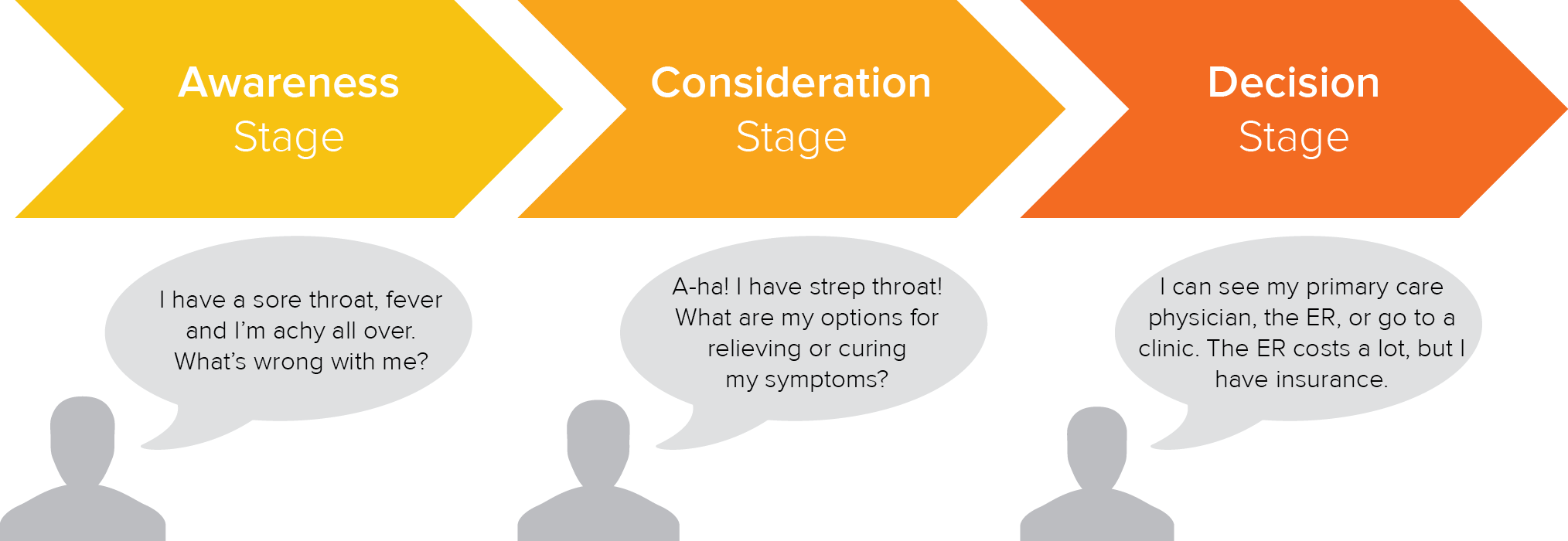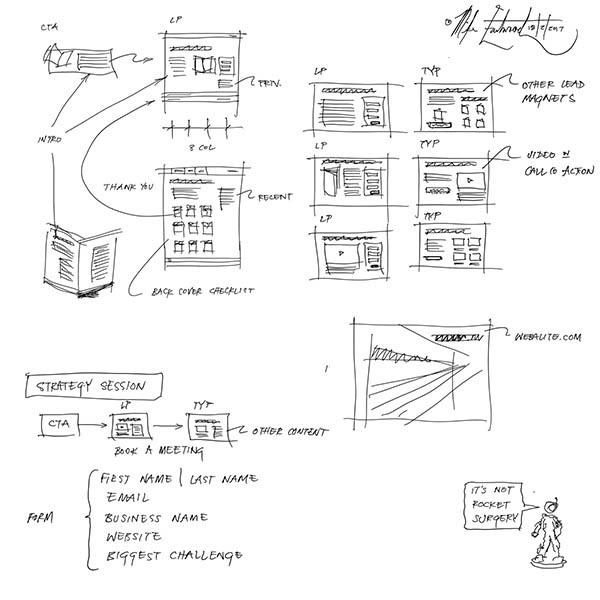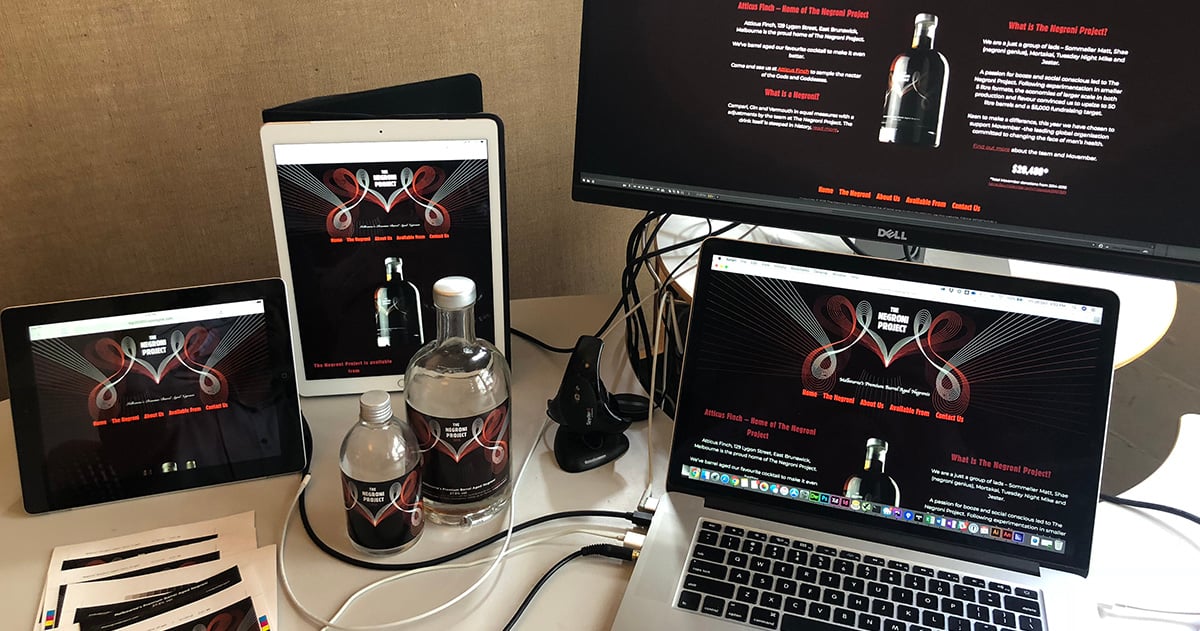Website Design and Website Development
You don’t get a second chance to make a first impression. According to three-year study from Stanford University, 75% of users admit to making judgments about a company’s credibility based on their website’s design.
Website design is more than just colours and fonts. Your website needs to be fast, easy to use on any device and optimised to get results – specifically more traffic, more leads and more of the right type of customers.
You’ve heard me say before “Nobody wants a website” so why am I now telling you how important your website is?
Ultimately your website is the container to both deliver content and capture those lead so it's extremely important. Your website is the hub for all of your digital marketing activity.
Yes, you need a website.
Sure you can build your online business on Facebook, but what happens if they change the rules? If Facebook changes the rules – to their game – you could lose your entire marketing channel overnight (we’ve seen it happen).
Owning your own website is a lot of work but it’s always yours, your email list is not going to disappear overnight because you didn’t comply to your own terms and conditions.
What is the purpose of your website?
Before you start working on your website you should ask yourself "what is the purpose of your website?".
Your website's purpose could be one or more of the following:
- Help people get in touch with you quickly and easily
- Share information about your products or services
- Increase your authority in your market making you the expert
- Generate leads for your sales team
- Help your sales team convert leads into customers
- Automate process and systems e.g. customer onboarding
- Business processes to your customers and team
Your website is not about you
Your website is about your visitors, your leads and your customers and their needs, wants and desires. Your content is designed to help your visitors, connect with them and help them along the Buyer’s Journey.
Your website design is designed for your ideal customers – not you.
You may like a particular style, or look, but unless you represent your ideal customer then your style preferences are less relevant than the people you’re trying to attract to your website.
So, how do we design a website for our target market?
Personas
A Persona, or Avatar, is a fictional character that represents your ideal target customer. Creating a Persona helps your team define your target market so they are easy to visualise, making it easier for you to communicate with them.
- Personas make it much easier for designers to create imagery, typography and colour palettes that connect with your ideal Persona.
- Personas make it easier for everyone to create compelling content which talks directly to your ultimate customer.
- Personas make it easier for developers to understand the intention so they can develop with them in mind.
When a visitor comes to your site they are at some stage of the Buyer's Journey which will shape the content, more than the design, but it’s still relevant to the design process.
What is the Buyer’s Journey
The Buyer’s Journey is the process buyers go through to become aware of, evaluate, and purchase a new product or service. More than ever the Buyer’s Journey is in the control of the buyer, not the salesperson nor the marketer.
This journey, as you’ve probably experienced, is never a linear path and often never a predictable timeframe. However, you can help your buyer along the Journey in a helpful friendly way.
The Buyer’s Journey is a three-stage process:
- Awareness Stage
- The buyer realises they have a “problem”.
- Consideration Stage
- The buyer defines their “problem” and researches options to solve it.
- Decision Stage
- The buyer chooses a solution.

Is your Website an Expense vs. Asset
A website that fails to attract visitors and/or collect leads for your sales team is a business expense.
Conversely if your website attracts visitors, converts them to leads and helps your team land new customers then your website is a profitable investment giving you a Return On Investment (ROI).
Your Website Progression from an Expense to an Asset
Unfortunately, your website will never actually be finished, however you can continually improve your website.
Over the last decade we’ve mapped out this progression from your website being an expense to an asset that generates an ROI:
- No Website
- It’s better to get something online – as soon as possible. Even a Splash Page with your contact details is better than nothing, but far from effective.
- Splash page
- A Splash Page is good to hold the space and let Google know something’s coming. At a minimum you need to have your name, an introduction and contact details. Remember “progress over perfection”, you need to publish content to compete online.
- Online brochure
- In the early days of the web people put their brochures online. A good start... but ineffective for attracting visitors and unlikely to generate any leads. If you have some existing content – even if it’s old brochure content – it’s good to publish it on your website while you work on the next steps.
- Authority Website
- By publishing high quality, high value content regularly you attract visitors and search engines. Become a “thought leader” in your industry, share your expertise. Rather than trying to outsell your competitors you should aim to out-educate your prospects so you become an authority in your market.
- Marketing Machine
- When your website is delivering high value, useful and engaging content – and collecting visitor’s information – you will start to see a return on your investment. With additional offers visitors can exchange an email address for additional high-value content, webinars or other events. Your visitor has now been converted from a visitor to a lead.
- Sales & Marketing System
- With the right systems in place your sales team can see what your leads have been looking at, understand their needs, and help educate them. When your sales team are helping people that have expressed interest in your products and services your sales team become trusted advisors.
Website Design
You don’t get a second chance to make a first impression. Your website design is often the first impression your business makes on your potential customers.
Differentiate by Design
Italy lead the global design revolution because they had dozens of competing manufacturers.
At first the factories would compete on price - they soon discovered that was a race to bankruptcy. Then quality became the competitive motivation - whoever could deliver the best quality at the best price won. It didn't take long for the playing field to level again. Service soon equaled out as businesses competed for clients.
Design became the new differentiator. Every company hired Industrial and Graphic Designers to differentiate their product from their competitors. Soon the competition was so fierce, between local manufacturers, they led the world in product design.
You can also use design to help differentiate your business against your competitors. You will still need to work on Price, Quality and Service – design is the extra, intangible quality that can give you the edge.

Design and Branding
Your brand is much more than just a logo – your brand includes colour, typography, layout and both visual language and written language.
When your brand is focused you can portray quality (high or low), status, price, service and more. When applied consistently – across all mediums e.g. website, brochures, etc. – your brand portrays consistency. Conversely if you have some content with old logos, different brochures from different decades your brand shouts a lack of caring and consistency.
Remember – if you business targets low cost high volume customers then “high design” can actually discourage your potential customers the same way a cheap brand will detract from a high quality product.
We can design your website for you, or work with your website designer.
Mike’s background in design means Mike and his team of website designers can implement your website from the ground up. We can use your style manual to make your site fit with your other collateral, or work with your website designer (yes, we play well with others).

Design Programmes
We offer two standard Website Design packages a 9 week programme or a 12 week design programme, or we can tailor a package for your needs.

- 9 Week Design Programme
- This programme is suited to businesses with a strong brand and/or website redesign projects. This programme explores a single design concept to completion.
- 12 Week Design Programme
- This programme is suited when you want a fresh look at your brand or website wether it's a redesign or a new concept. This programme will come up with 3 design options, then refine one design through to completion.
| Week | 9 Week Design Programme | 12 Week Design Programme |
|---|---|---|
| 1 | Interrogation | Interrogation |
| 2 | Market Analysis | Market Analysis |
| 3 | Marketing Workshop | Marketing Workshop |
| 4 | Splash Page | Splash Page |
| 5 | ||
| 6 | Concept Presentation | |
| 7 | Concept Presentation | |
| 8 | Theme Presentation | |
| 9 | Website Launch | Second Concept Presentation |
| 10 | ||
| 11 | Theme Presentation | |
| 12 | Website Launch | |
Need a complete design package including logo and brand? we're happy to help.
The Design Process
Two decades of design work have helped Mike Eastwood hone this design process…
Here’s the summary of what we learnt working on everything from branding, brochures, billboards, video and over the last decade websites, banners and digital content.
- Research & Discovery
- Sketching on [digital] paper
- Low-fi Design Mock-ups
- Hi-fi Design Mock-ups
- Design concept presentation
- Design development
- Design implementation
- Design testing and improvement
- Apply the design to other channels
- Refinement and improvement.
You can learn more about our Design Process and what we'll need from you.
Website Development
You can get a website – out of the box – and start publishing content. However, with almost every project there comes a time when you want to deliver more functionality, or custom content, and for that we need to develop custom solutions to deliver what you need.
Development Process
After decades of working on software development, website development and building apps has shaped our workflow over the last decade.
We've adopted and adapted a number of processes that make development more effective and efficient – ultimately reducing risk.
- Planning
- The first stage of development is planning. Call me old school but we can work out a lot of stuff with pen and paper before we start writing any code. “Measure twice, cut once,” as the chippies say.
- Research and documentation
- We need to fully understand your processes fully – to the point where our team can perform the entire process without you.
- User Stories
- We create sets of "tasks" that a user would perform and rewrite them as a User Story. This means we can think about the functionality as a user rather than the technical requirements. Once we have all the User Stories we can create the technical tasks to complete the User Story.
- Mockups and Flowcharts
- We create clickable mockups (mockups focussed on content and process over design). Clickable mockups allow us to thoroughly resolve any new business processes or workflows before a line of code is written.
- Design mockups
- Once we've resolved the functionality then we can apply the design to the mockups. Again, we've resolved all the look and functionality before we've written any code.
- Agile Project Management
- Now we know what's required we can plan and schedule the project using Agile methodology. Tasks are grouped into Sprints which are short focussed periods usually a few weeks long. At the end of the Sprint we report back what’s been completed before planning the next Sprint.
We have the combined skills to apply a variety of tools to suit your job. We can recommend an appropriate solution for your project and we will continue to offer you solutions during and after the job if something catches our eye and we think it would be the right fit for you.
All code is tested throughout the development process to ensure the website works consistently on iOS and Android on phones and tablets plus laptops and desktops on both Apple and Windows.
Now you've invested all that time, effort and budget in your website and your marketing... please, please, please don't skimp on hosting.
Website Hosting vs. a Supported Website
Over the last twenty years I've worked with website hosting companies all round the world. We've managed sites for clients using other website hosts, we've set up hosting environments on servers and migrated websites between servers.
In 2014 we arrived at the ultimate solution for website owners – the WordPress Supported Site.
Unfortunately most companies offer Website Hosting.
Website Hosting
The old model was to install your website on a shared server and offer you email and/or telephone support (I use the term "support" generously – if you've called a "help" desk you know what I mean).
Your website sits on a server with hundreds of other websites, the hosting company does as little work as possible to maintain the server because changing stuff is expensive and they charge low prices.
Similarly the infrastructure is cheap (old and/or slow) because they are providing low cost services to so many low traffic sites... so your site runs slowly.
Updating sites can cause issues that require technical expertise to fix, so it's too risky for the server company to run anything other than critical updates.
WordPress Supported Website
Your site will be installed in a custom environment designed exclusively to host WordPress websites in the cloud. Because the entire system is designed for WordPress your site is speedy, secure and safe.
On top of the base system we've installed a number of proprietary and other paid products to get the highest performance from your site.
We then add monitoring, analytics and other reporting to ensure your site is delivering content quickly to your visitors.
We run automated and manual updates to ensure your site has the latest security patches and new features.
And, we support you in English (not geek-speak) on the phone and/or email.
Next Steps
Ok, I've just dumped a load of information on you... here's what to do next:
- Download the Website Design Checklist so you can compare apples to apples (and avoid lemons).
- Download the Website Development Checklist so you don't get caught out trying to save a few dollars by hiring a cheap developer.
- Book a Strategy Session with Mike Eastwood so he can learn more about your goals and recommend some solutions.
- Share this page with anyone else in your team to help them get on the same page.
If you have any other questions please contact Mike Eastwood using the form below.



